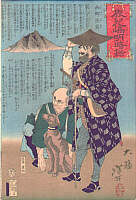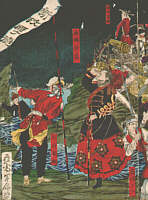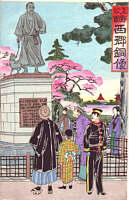Last Samurai...part 2:
The Satsuma Rebellion of 1877
The Final Battle, from a triptychby Toshinobu Yamazaki
In the beginning of the Meiji government, many samurai found an employment in the imperial forces. The new conscript army must have been rather unattractive for the samurai. Thus the samurai class not only lost all privileges, but many saw themselves deprived of any possibilities to make a living and maintain themselves and their families.
As a consequence local riots broke out like in Saga in Kyushu province in 1874. The central government could not tolerate any losses of power or establishments of independant, regional war lords and crushed these riots swiftly by sending the newly formed national army into the region to restore law and order.
Wearing swords was forbidden in 1876 with the exception of ceremonial events. Overall a reasonable and appropriate decision. But it upset the majority of the samurai.
In 1876 Saigo Takamori resigned from his government post and went back to Kagoshima. He founded a local military school and dissatisfied samurai gathered around him in large numbers.
The central government watched the open build-up of a regional, political and military force in Satsuma with great concern. In late 1876 it came to an open conflict when samurai rebels raided and occupied ammunition and weapon depots of the central government.
The samurai rebels urged and proclaimed Saigo Takamori as their leader. According to most historians, he was surprised by the swift escalation of the situation and only reluctantly took the leadership of the rebellion. Half-hearted or not, Saigo organized the military rebellion and put together an army of roughly 25,000 men that later may have grown in size, when more samurai volunteers rushed to the rebel forces.
Saigo had the original intention to march with his army towards Tokyo. His first military charge was the siege of the imperial garrison in the castle of Kumamoto. That was probably a decisive military mistake. While Saigo's army was bound by the siege, the government gained additional time to deploy troops and bring military supplies to the South.
Indeed, the central Meiji government, legalized by a decrete to crush the rebellion - signed by the emperor - acted swiftly and sent the new national army. The siege of Kumamoto castle was ended after 54 days. Saigo's troops were defeated and slowly pushed back to Kagoshima in the utmost South.
The Last Battle
After numerous skirmishes and battles, Saigo Takamori with a small number of roughly 300 die-hard samurai gathered for a last stand in the hills of Shiroyama not far away from Kagoshima Castle and with a great view upon the sea.
By now, the rebels were hopelessly outnumbered, short of food, bare of ammunition and exhausted. It had been raining for days which made their old-fashioned cannons unuseable.
By now, Saigo and his last men knew that they had no chance and that their cause was lost. What kept them from surrendering was this strange (for Western minds) perception of honor. "An honorable death is preferable to a life in shame." To some unconfirmed reports, the commander of the imperial forces had sent a last letter to Saigo urging him to give up the hopeless fight.
In the early morning hours of September 24, 1877, the final artillery bombardment began. We could not find any detailed reports about the battle. This is probably an indication that the assault was not a hand-to-hand combat, but an artillery massacre against a small group of men who virtually had only their swords left to defend themselves.
The bodies of Saigo Takamori and other leaders of the rebellion were found beheaded. The last samurais had committed
seppuku by cutting off each other's head with one strike of the sword. This was the traditional samurai way of committing suicide on the battlefield when no time was left for a ceremonial suicide.
Saigo Takamori - a Tragic Hero?
Statue in Ueno Park
Saigo Takamori was revered by the ordinary Japanese people as a hero. And this attitude has not lost any of its momentum until our days - especially in the South of Japan. His esteem in the area of Kagoshima is best comparable to the esteem of General Robert E.Lee in Texas.
One can find a statue of Saigo Takakamori in full (Western) uniform in the Central Park of Kagoshima. And another - even more famous statue was erected in Ueno Park in Tokyo. It shows the great statesman and "last samurai" leisurely dressed in a kimono walking his dog.
Many years later, the Meiji government made a clever move. They pardoned the popular hero posthumously in 1889, promoted him to highest honours and did their best to establish the image of a tragic hero.
The Satsuma Rebellion and Ukiyo-e
The news of the Satsuma rebellion had created a great thirst among the public to learn and view more about the events. Many ordinary Japanese could not at all or only poorly read and write at that time. And photography was still at its beginning. Therefore images made in traditional Japanese woodblock technique were a major means of bringing exciting events to the public.
Japanese newspapers employed or gave commissions to popular woodblock designers like Yo****oshi. And for print publishers it was a good business in a generally reclining market.
The impression quality of these prints is not always the best. News related ukiyo-e was produced fast. Those who were on the market first, made the business. Collectors should know this and should be willing to make compromises. The charm of these designs and the value lie more in the historic subject and the rarity of individual designs. Also
yokohama-e, images of Westerners and their customs and achievements are in this category.
Prints related to the Satsuma rebellion were designed by more or less all artists of the period like Kunichika or Yo****ora. And at the head of the pack was of course
Yo****oshi - the leading designer for sensational subjects of crime and blood.
For Yo****oshi, who for years had hardly enough to eat, the huge demand for popular illustrations of the Satsuma rebellion was like a turning point of his career. He was flooded with commissions. And 5 years later, in 1882 he received a steady employment by Tokyo's leading newspaper.
 .
. . My apologies for that.
. My apologies for that.


